The heart shape is undeniably one of the most romantic and captivating diamond shapes. With its brilliant cut and stunning reflection, it effortlessly conveys the essence of love to anyone who beholds it.
Heart-shaped diamonds have become a sought-after choice for engagement rings and anniversary gifts, symbolizing love, passion, and unwavering commitment. But what exactly is a heart-shaped diamond?
A heart-shaped diamond is derived from the round brilliant cut, albeit with some modifications. Creating a perfectly symmetrical heart gem requires exceptional skill and precision on the part of diamond cutters.
If you’re intrigued and eager to learn more about heart-shaped diamonds, continue scrolling for further insights.
DESIGN YOUR OWN ENGAGEMENT RING: START WITH A SETTING OR START WITH A DIAMOND. IT’S REALLY UP TO YOU!
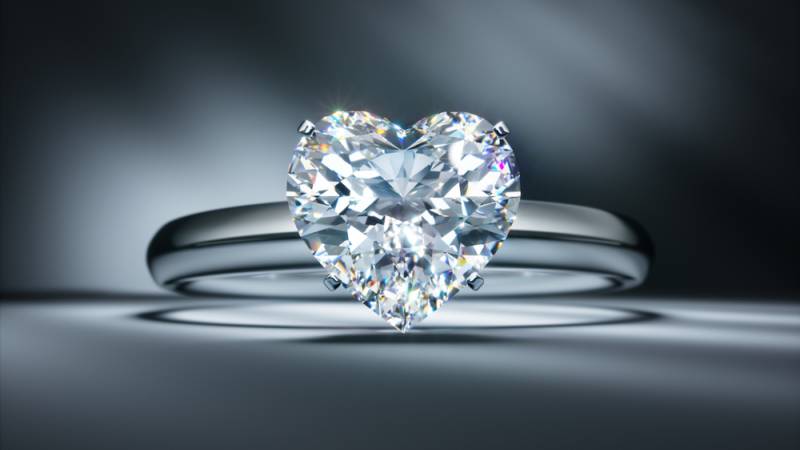
What Is A Heart Shaped Diamond?
The heart-shaped diamond is a unique and distinctive variation among the more common diamond shapes, symbolizing eternal love and affection.
The earliest recorded sighting of a heart-shaped diamond dates back to the 16th century, when Mary Queen of Scots presented Queen Elizabeth with a heart-shaped diamond ring in 1562, marking its initial popularity.
While heart-shaped gems can be found in various jewelry pieces like earrings and bracelets, they are most commonly used as the focal point in diamond engagement rings.
Round brilliant diamonds dominate the market, accounting for more than two-thirds of all diamond sales. In contrast, heart-shaped diamonds constitute a small percentage, making them a rare and exceptional choice.
Unfortunately, many diamonds available in the market are poorly cut and lack luster. This is primarily due to the absence of standardized cut grades for fancy-shaped diamonds, unlike round brilliants which have gemological lab reports to assess their cut quality.
A well-cut heart-shaped diamond typically consists of 56 to 58 facets, with the pavilion featuring six to eight facets. When cut to high-quality standards, a heart-shaped diamond can exhibit exceptional brilliance and a striking form that beautifully reflects the love shared between you and your partner.
The appearance of heart-shaped diamonds can vary significantly based on their length and width proportions, greatly influencing their overall look. In the following sections, we delve into these factors in detail and provide additional guidance on selecting the perfect heart-shaped diamond for your ring, pendant, or other jewelry pieces.
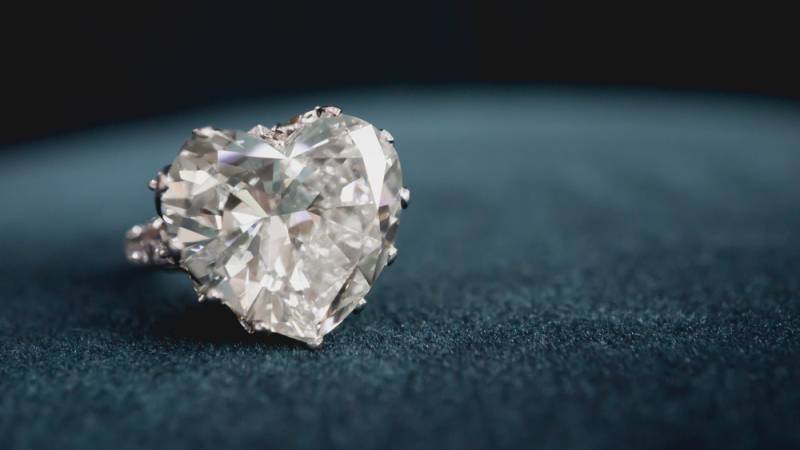
The Cut Of Heart Shaped Diamond
When considering heart-shaped diamonds, the quality of the cut becomes a crucial factor to examine due to their unique appearance.
Unlike round brilliant diamonds, heart-shaped stones do not have specific cut specifications set in stone. The reason behind this is the personal preference involved in determining the stone’s ratio. Some individuals prefer a longer, more elongated heart shape, particularly for pendants, while others prefer a rounder and more symmetrical heart shape.
However, determining the cut grade of a heart-shaped diamond is not as straightforward as reading a GIA certificate, which provides detailed cut grades for round brilliants and other popular shapes.
Unlike other shapes, a GIA certificate accompanying a heart-shaped diamond may not provide a specific cut grade. This means that the grading report does not offer a comprehensive assessment of the diamond’s cut quality.
For instance, if a diamond has an excellent cut grade specified on its GIA certificate, you can be confident that you are purchasing a well-cut diamond with optimal symmetry and a beautiful appearance.
The challenge arises when a diamond lacks an overall cut grade, making it difficult to assess the diamond’s cut quality solely based on its grading report.
Therefore, it is crucial to thoroughly examine any heart-shaped diamond before making a purchase. This allows you to assess its cut, symmetry, and overall visual appeal to ensure it meets your desired standards.
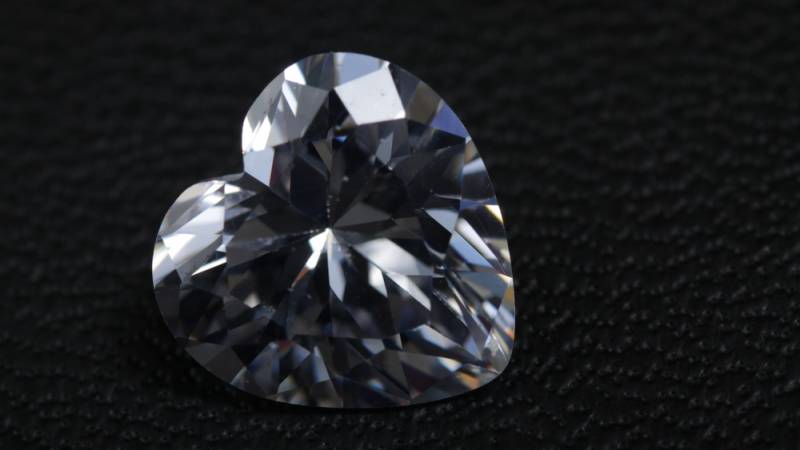
Heart Shape – Length To Width
Heart-shaped diamonds, like other non-round shapes, vary based on additional parameters, with the length-to-width ratio playing a significant role in their aesthetics and attractiveness.
However, customer preferences differ, and beauty is subjective. Some individuals prefer an elongated design, while others prefer a rounder contour. This personal choice does not impact the quality of the diamond unless the dimensions negatively affect its light performance.
The proportions of a fancy-shaped diamond are indicated on a GIA report as length x breadth x depth. To determine the length-to-width ratio, simply divide the length by the breadth.
The ideal length-to-width ratio for a heart-shaped diamond is 1.00, which means it is perfectly proportional in terms of length and width. Heart-shaped diamonds with a near-ideal or perfect length-to-width ratio will appear balanced and natural, without looking excessively elongated or stretched.
Diamonds with a ratio below 0.90 will appear “fat” and overly wide, so it is advisable to avoid them. Similarly, diamonds of this shape with a ratio of 1.10 or higher often appear elongated, stretched, and too thin.
For the most visually appealing result, it is recommended to choose a heart-shaped diamond with a ratio as close to 1.00 as possible. Unless specifically seeking a wider or narrower diamond, it is best to avoid gemstones that fall outside this range.
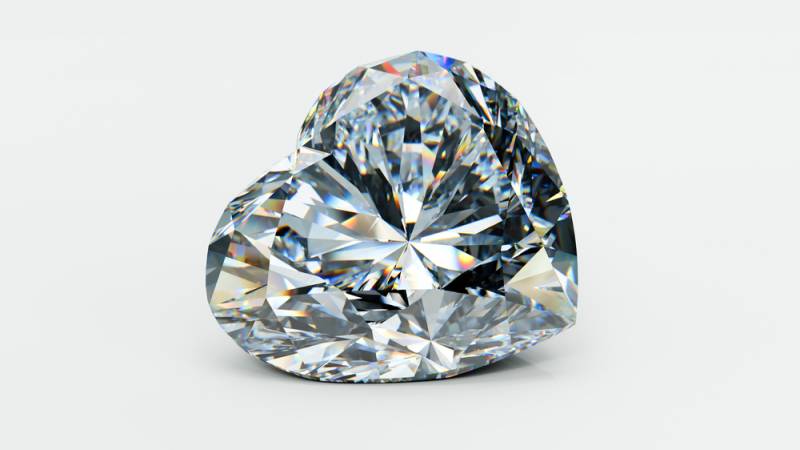
Girdle Thickness In Heart Diamonds
The girdle of a diamond refers to its outer edge and serves two purposes: protecting the stone and providing a surface for setting. In the GIA grading lab, the girdle is examined and characterized based on its thinnest and thickest points.
On a grading report, you might see descriptions like “medium – moderately thick” or “thin – thick.” It’s important to note that “thin” and “thick” are relative to the diamond’s diameter, with thin being around 0.6% and thick around 3%.
This means that a 2-carat diamond with a girdle thickness labeled as thin would appear significantly larger than a 0.5-carat stone with a thin girdle.
Unlike round diamonds, where girdle thickness is considered in determining cut quality, this is not the case for fancy shapes. In fact, slightly thicker girdles can offer additional protection to the diamond’s corners by adding mechanical strength.
However, there are pros and cons to a thick girdle. On one hand, it can make the diamond appear smaller because some of the weight is distributed in the girdle.
Now, let’s discuss the reality of diamond cutting: The majority of fancy-shaped diamonds are cut to maximize weight retention and increase profit for the jeweler or cutter, often at the expense of cut quality.
Some people may think that selecting diamonds with thin girdles is a great way to enhance size and value. Unfortunately, this is not advisable, especially in terms of durability.
It’s important to find the right balance in girdle thickness. Look for a diamond with a girdle ranging from thin to thick. However, there are no strict rules governing the upper limit of girdle thickness.
For example, if the pricing is reasonable and the diamond exhibits excellent light performance, it may still be worth considering stones with “somewhat thick” or “extremely thick” girdles.
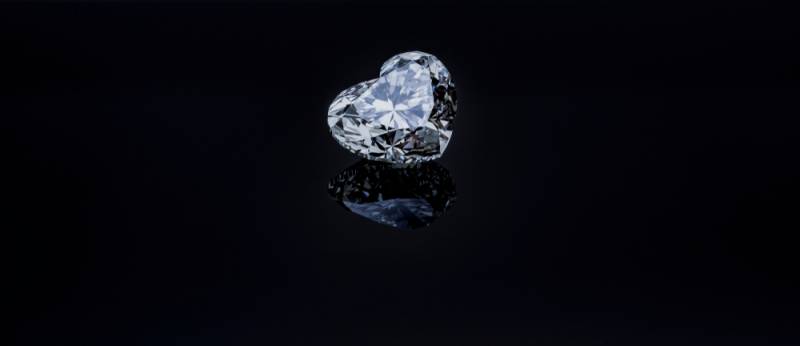
Table And Depth
Heart-shaped diamonds, like other diamond shapes, have a flat top facet known as the table.
The size of the table, expressed as a percentage of the diamond’s width, plays a crucial role in determining how much light can enter the stone and reflect off its other facets, creating a sparkling effect.
Ideally, a heart-shaped diamond should have a table that accounts for 56 to 62% of its total width. However, stones with a table ranging from 54 to 64% can still look excellent and are worth considering if they meet the other criteria for cut excellence.
The depth of a diamond is measured from top to bottom and is also represented as a percentage of its width. For heart-shaped stones, it is recommended to choose a depth ratio of 56 to 66 to ensure enhanced brilliance and sparkle.
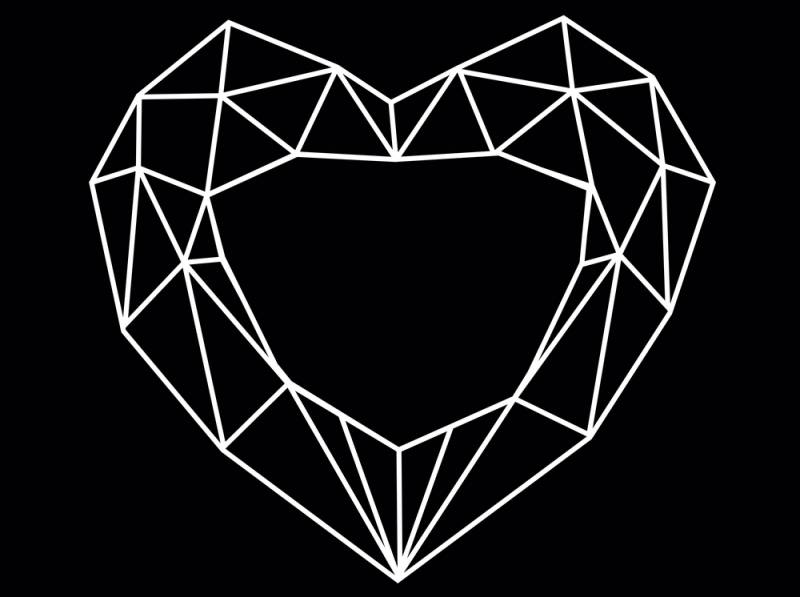
Importance Of Symmetry In Heart Cut Diamonds
The symmetry of a heart-shaped diamond is a crucial aspect to consider. Symmetry refers to how well the diamond’s facets are proportioned and aligned with each other, ultimately affecting its beauty and appeal.
Due to the intricate shape of a heart, there are multiple criteria to assess the symmetry of the stone. These include the cleft, which is the inward-facing edge at the top, the point, which is the tip at the bottom, and the lobes, which are the rounded sections forming the heart shape, as well as the belly and wing of each half of the diamond.
It’s important to ensure that the diamond exhibits symmetry beyond just the cleft and tip. Pay close attention to the lobes, the upper circular sections forming the top of the heart, for any irregularities.
In an ideally symmetrical heart-shaped diamond, if you mentally draw a straight line from the cleft to the tip, the opposing sides should appear equal, with no noticeable differences in facets or lobe size.
A diamond with a “fair” symmetry grade will have noticeable variations in the lobes, making it less desirable. On the other hand, a diamond with an “excellent” symmetry grade will exhibit well-balanced lobes and maintain a clean and defined outline.
It’s worth noting that symmetry refers to the alignment of the diamond’s sides and does not necessarily indicate a distorted overall shape of the stone.
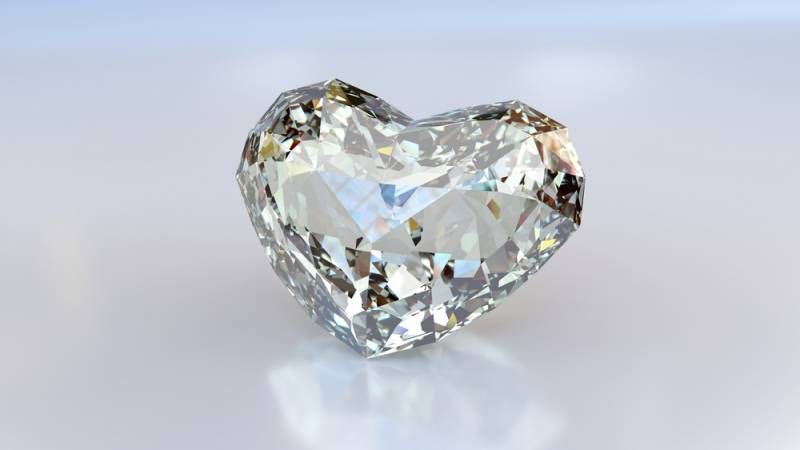
Heart Shaped Diamond’s Color
The diamond color grading system established by the GIA ranges from D to Z, where D represents a colorless and transparent diamond, while Z indicates a diamond with a noticeable yellowish-brown tint.
Heart-shaped diamonds, being a variant of the round brilliant cut, are known for reflecting a significant amount of light, making it more challenging to detect their color compared to diamonds with larger table facets.
As a result, there is no need to pursue a flawless color grade for a heart-shaped diamond. Paying more for a higher color grade would have no discernible impact on its visual appearance to the human eye.
There isn’t a universal color grade that guarantees the best value for heart-shaped diamonds. Instead, the choice of color should be based on the metal used for the setting.
For platinum or white gold settings, it is generally recommended to opt for a diamond with a color grade of H or better. A lower color grade can be acceptable for settings made of yellow or rose gold.
In general, for solitaire settings, we recommend considering a color grade of J or higher. Diamonds in these color grades may exhibit a faint yellow hue, but when set in metals like rose or yellow gold, they still appear visually clear.
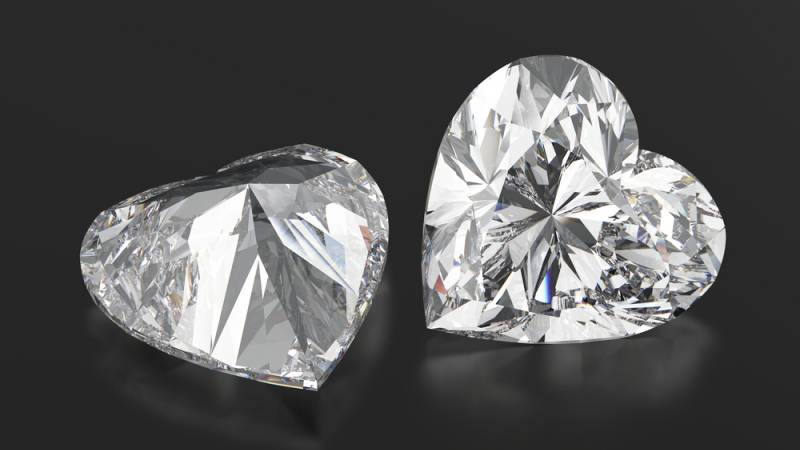
Heart Shaped Diamond’s Clarity
Clarity refers to the level of purity in a diamond as observed by a gemologist. Diamonds with high clarity ratings have minimal inclusions, while those with lower clarity grades may exhibit noticeable inclusions.
When it comes to assessing clarity in heart-shaped diamonds, it is a subjective matter. The clarity grades provided by GIA offer valuable guidance, but it’s important to consider individual preferences.
For some individuals, as long as the inclusions are not visible to the naked eye, they are satisfied. Others may prioritize a technically flawless appearance.
In general, it is recommended to look for an eye-clean diamond, which means that no flaws or imperfections are visible to the naked eye.
In the case of heart-shaped diamonds, clarity ratings of “Small Inclusions” and higher typically result in an eye-clean diamond. Minor inclusions, such as those found in most VS2 (Very Small Inclusions) diamonds, are generally not noticeable to the human eye due to the modified brilliant-cut of this shape.

The Suitable Carat Weight For Heart Shaped Diamond
Heart-shaped diamonds, like other diamond shapes, are available in a variety of carat sizes. When selecting a diamond, it is advisable to choose the highest carat weight that fits within your budget.
By prioritizing carat weight and being more flexible with clarity and color grades, you can often obtain a larger diamond than you may have initially anticipated. With a substantial carat weight, the heart shape of the diamond becomes more visually prominent and appealing.
In general, it is recommended to consider a heart-shaped diamond that weighs one carat or more. A diamond of this size allows the heart shape to be more easily recognizable, whereas the heart shape of a smaller diamond may be less noticeable once it is set in a piece of jewelry.

Conclusion
Now, let’s recap what we’ve learned about the enchanting heart-shaped diamond.
A well-cut heart-shaped diamond can make a stunning centerpiece in a ring, earring, or any other piece of jewelry, offering excellent value for money compared to a round diamond of similar size. It is important to carefully consider the quality characteristics discussed in this article when selecting a heart-shaped diamond.
When searching for a heart-shaped diamond, aim for a length-to-width ratio that is as close to 1.00 as possible. This will ensure that the heart shape is prominent and well-proportioned. Additionally, consider choosing a diamond that weighs one carat or more to fully showcase the beauty of the heart shape.
Just like any other diamond, it is crucial to choose wisely to obtain exceptional quality for a diamond that holds such sentimental value, without exceeding your budget.


